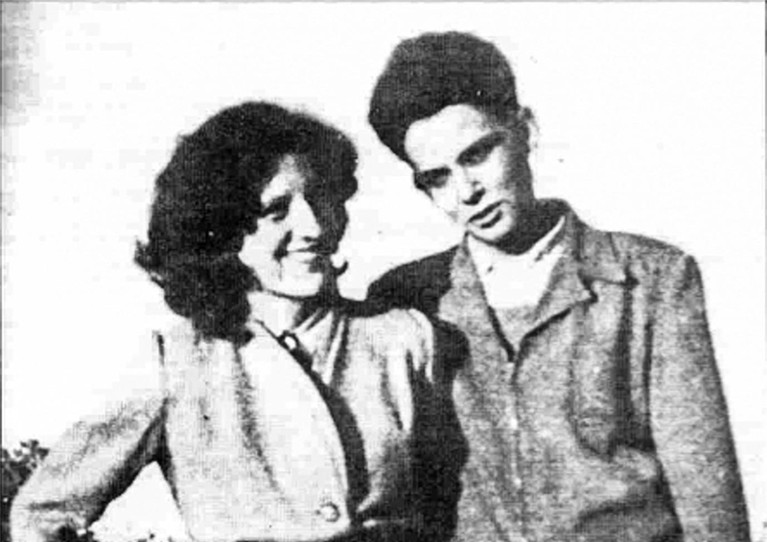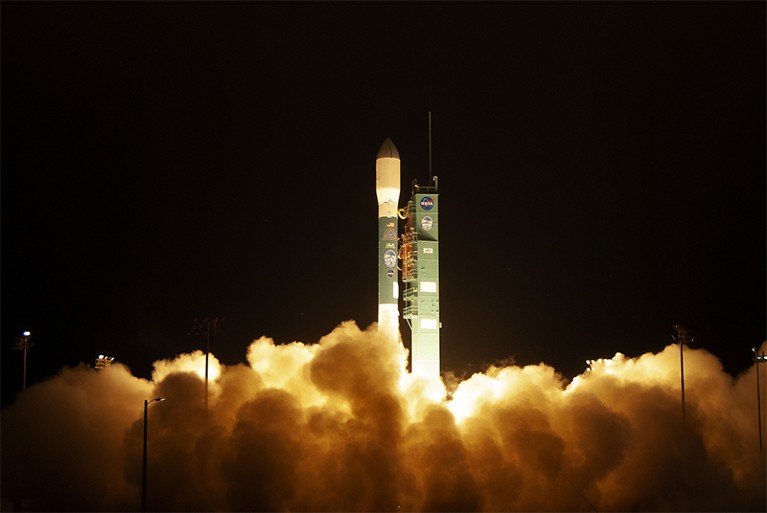EVENTS
France admits role in lecturer’s murder French President Emmanuel Macron has officially recognized that the French army tortured and killed mathematician Maurice Audin during the Algerian War of Independence. Macron presented a statement to Audin’s 87-year-old widow, Josette, at the family home near Paris on 13 September. Audin was a French university lecturer in Algiers and a member of the Algerian Communist Party. He disappeared in June 1957, and the authorities claimed that he had escaped after being arrested for harbouring communist-party members. Macron’s statement also acknowledged — for the first time — that the French army systematically used torture during the war. It added that all records for people who disappeared during the conflict would be made open.

French mathematician Maurice Audin (right), who was murdered in 1957, and his wife Josette.Credit: Alamy
Cochrane board The 13-member board of the prestigious medical-evidence group the Cochrane Collaboration has seen a slew of resignations. On 14 September, board member Peter Gøtzsche said he had been expelled from the collaboration with no clear justification. Cochrane told Nature that it had received “numerous complaints” about Gøtzsche, after he co-authored a critique of the Cochrane’s review on the human papilloma virus vaccine. Four elected board members quit in protest, requiring two appointed members to step down to maintain a mandated balance. The ructions came as the group had its annual meeting in Edinburgh, UK.
PEOPLE
Charges dismissed A judge in Los Angeles County, California, has dismissed a criminal case against chemist Patrick Harran, who faced charges of violating health and safety standards after an accidental death of a young researcher in his laboratory in 2009. The charges stemmed from an incident in which Sheharbano Sangji, a research assistant in Harran’s lab at the University of California, Los Angeles, died from third-degree burns incurred during a chemical fire. Sangji was handling t-butyl lithium with a syringe when the compound exploded into flames. Under a 2014 agreement with law-enforcement officials, Harran had to meet certain terms — including speaking to university students on lab safety — or see his case go to trial. The judge determined that Harran had met the terms of the agreement, and dismissed the charges on 6 September, according to Thomas O’Brien, Harran’s lawyer.
RESEARCH
Fungus alert Fungal pathogens are spreading rapidly across the world and increasing the risk of diseases in plants and natural ecosystems, warns a report released on 12 September. The report, by London’s Royal Botanic Gardens, Kew, is the first to examine the state of fungi worldwide as well as their role in natural ecosystems and human health. Climate change is already affecting the health and reproduction of the organisms, says the report. Fungi first appeared on Earth about 1 billion years ago, and most plants rely on them to thrive. But the kingdom is less well studied than plants and animals because the organisms are perishable and are often hidden from view. Scientists think that Earth hosts up to 3.8 million fungal species, but only about 144,000 have been classified, at a rate of around 2,000 a year.
SPACE
Satellite launch NASA’s Ice, Cloud, and land Elevation Satellite-2 (ICESat-2) launched from the Vandenberg Air Force Base in California on 15 September (pictured), kicking off a three-year mission focused on tracking ice thickness. The satellite will also measure cloud heights and forest growth. The craft’s Advanced Topographic Laser Altimeter System (ATLAS) can track changes in ice thickness to within half a centimetre per year. The data it collects will provide seasonal and annual information that can better inform predictive models of melting ice and rising sea levels. Researchers conceived the mission in 2008, but it took about five years to develop ATLAS. Technical difficulties and budget considerations then delayed the ICESat-2 launch until this year.

NASA’s ICESat-2 launched from Vandenberg Air Force Base in California on 15 September.Credit: Kim Shiflett/NASA
Space agency Luxembourg launched a national space agency on 12 September. Nestled in the country’s economic ministry, it is aimed at advancing space initiatives in business rather than building and launching spacecraft. Luxembourg has long been involved in the space industry, and is the base for commercial satellite operators such as Intelsat and SES. In 2016, the country established a space-mining initiative to explore who would own minerals extracted in space. The Luxembourg Space Agency will involve business, academia, non-profit organizations and other partners to promote economic development in space. It aims to create a €100-million fund (US$117 million) to help finance new space businesses.
AWARDS
Lasker awards Pioneers in anaesthesiology, DNA packaging in chromosomes and RNA biology are this year’s recipients of the Lasker awards. The annual biomedical research prize, announced on 11 September, is often considered a precursor to the Nobel prize. John Glen, a scientist formerly at the drug company AstraZeneca in London, won the clinical award for his discovery of the anaesthetic propofol. Joan Argetsinger Steitz of Yale University in New Haven, Connecticut, won the special achievement award for her work on RNA and for promoting women in science. And the awardees for basic science were C. David Allis of the Rockefeller University in New York City and Michael Grunstein of the University of California, Los Angeles, who discovered how chemical modifications to certain proteins on chromosomes can turn genes on and off. Each award comes with a US$250,000 honorarium.
Chinese accolades Yuan Longping — the ‘father of hybrid rice’ — and two other rice researchers have won the Future Science Prize for the life sciences. Yuan shares the award with Zhang Qifa and Li Jiayang from the Chinese Academy of Sciences. The prizes — often called China’s Nobels — honour discoveries made in the nation, and each of the three awards is worth US$1 million. Ma Dawei at the Shanghai Institute of Organic Chemistry, Feng Xiaoming at Sichuan University and Zhou Qilin at Nankai University shared the physics prize for discovering catalysts that can synthesize drug molecules. Lin Burn, formerly at the Taiwan Semiconductor Manufacturing Company in Hsinchu City, took home the mathematics award for improving a technique to manufacture integrated circuits.
POLICY
Methane proposal On 11 September, the US Environmental Protection Agency (EPA) announced a proposed rule that would relax regulation of methane emissions at oil and gas facilities. The plan would roll back key provisions of the methane regulations put in place under former president Barack Obama in 2016. The plan includes a reduction in the frequency of emissions monitoring at oil and natural-gas wells, and at facilities that compress gas for transport through pipelines. It also extends the time that companies have to fully repair leaks of this potent greenhouse gas from 30 days to 60 days. The EPA is soliciting comments for 60 days, and plans to hold a public hearing on the proposed rule in Denver, Colorado.
Harassment policy The US National Institutes of Health (NIH) is rethinking how it handles sexual harassment. The agency will soon introduce a centralized system for reporting harassment by NIH scientists, director Francis Collins said on 17 September. The agency has launched an anti-sexual-harassment website. It will also update its harassment policy, launch training and education campaigns to prevent harassment, and survey its staff and contractors about workplace climate and harassment issues. The moves come several months after the National Science Foundation announced that it would update its harassment policies.
TREND WATCH
Ten years ago, the world’s economy came crashing down — a crisis encapsulated by the demise of the US investment bank Lehman Brothers, which filed for the largest bankruptcy in history on 15 September 2008. A decade on, Nature looks at how funding for research — which relies on both government and private investment — has fared around the world. Data from the Organisation for Economic Co-operation and Development show that there has been a steady growth overall in research and development (R&D) funding since the initial aftermath of the crash. Among the organization’s 36 countries — which include the United States, Japan and many European nations — R&D funding from businesses dipped briefly after the crash, but then recovered, and has climbed since. Government funding generally rose in the two years after the crisis, possibly reflecting countries’ attempts to stimulate their economies. But disparities exist between nations. In European countries hit hardest by the recession, such as Greece and Spain, R&D funding from the government plummeted and has not fully recovered.

Source: OECD



